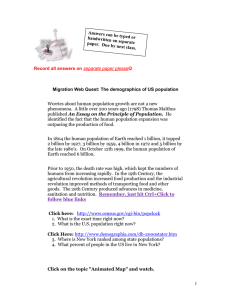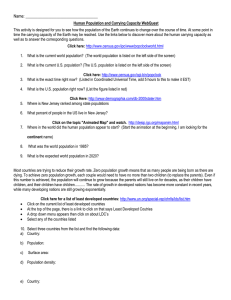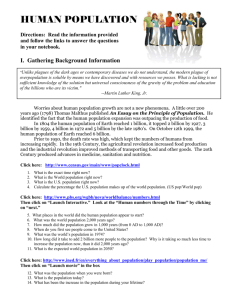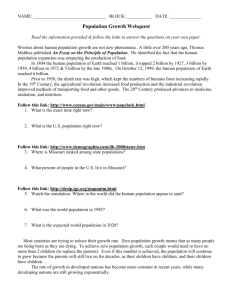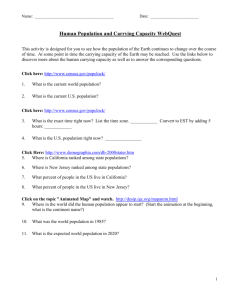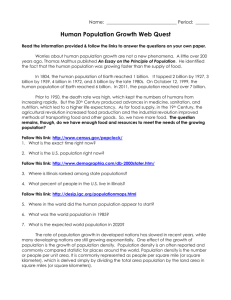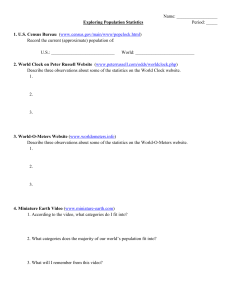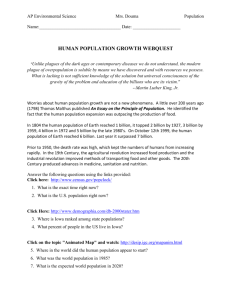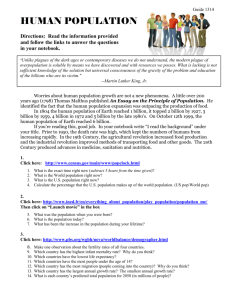Webquest Population and Migration
advertisement
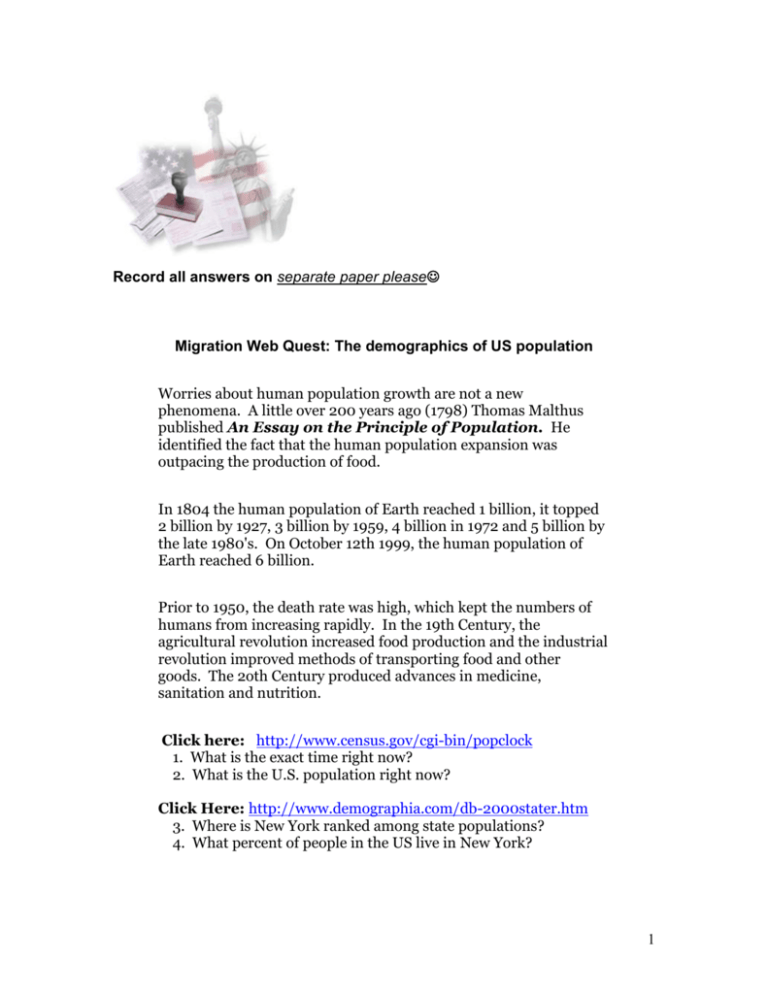
Record all answers on separate paper please Migration Web Quest: The demographics of US population Worries about human population growth are not a new phenomena. A little over 200 years ago (1798) Thomas Malthus published An Essay on the Principle of Population. He identified the fact that the human population expansion was outpacing the production of food. In 1804 the human population of Earth reached 1 billion, it topped 2 billion by 1927, 3 billion by 1959, 4 billion in 1972 and 5 billion by the late 1980's. On October 12th 1999, the human population of Earth reached 6 billion. Prior to 1950, the death rate was high, which kept the numbers of humans from increasing rapidly. In the 19th Century, the agricultural revolution increased food production and the industrial revolution improved methods of transporting food and other goods. The 2oth Century produced advances in medicine, sanitation and nutrition. Click here: http://www.census.gov/cgi-bin/popclock 1. What is the exact time right now? 2. What is the U.S. population right now? Click Here: http://www.demographia.com/db-2000stater.htm 3. Where is New York ranked among state populations? 4. What percent of people in the US live in New York? 1 Click on the topic "Animated Map" and watch. http://desip.igc.org/mapanim.html 5. Where in the world did the human population appear to start? 6. What was the world population in 1985? 7. What is the expected world population in 2020? Go back to the US population data: http://www.census.gov/cgibin/popclock 8. What is the exact time right now? 9. How many minutes have elapsed since you answered question # 2? 10. What is the US population right now? 11. What was the gain in US population while you have been working on this activity? 12. What has been the gain in population per minute over this activity? Show your work. 13. What was the population gain per second over this activity? 14. How does this compare with the stated gain per second on the census web site? Control Click to go to: http://www.ined.fr/jeux.php?_movie=/quizz/accueil_QCM.swf?lang=en&titre=Quiz&lg= en Click on “Are you a demographer” 15. Start with Easy and record your grade here (it will not count against you) _________ 16. Then Medium: __________score 17. Then Difficult: __________score Click here: http://www.pbs.org/wgbh/nova/worldbalance/numbers.html Then click on “Launch Interactive.” Look at the “Human numbers through the Time” by clicking on “next.” 18. What places in the world did the human population appear to start according to this map? 19. What was the world population 2,000 years ago? 20. How much did the population grow in 1,000 years (from 0 AD to 1,000 AD)? 21. When do you first see people come to the United States? 22. What was the world’s population in 1974? 23. How long did it take to add 2 billion more people to the population? Why is it taking so much less time to increase the population now, than it did 2,000 years ago? 24. What is the expected world population in 2050? Click here: http://www.ined.fr/en/everything_about_population/play_population/population_m e/ Then click on “Launch movie” in the box 2 25. 26. 27. 28. What was the population when you were born? What is the population today? What has been the increase in the population during your lifetime? Click on “The World Population and Me” on top of page. Record and compare the World Data, US Data and Middle African Data. Summarize the results and what may be the cause for the differences. II. Growth in Developing vs. Developed Countries "Which is the greater danger - nuclear warfare or the population explosion? The latter absolutely! To bring about nuclear war, someone has to DO something; someone has to press a button. To bring about destruction by overcrowding, mass starvation, anarchy, the destruction of our most cherished values-there is no need to do anything. We need only do nothing except what comes naturally - and breed. And how easy it is to do nothing." --Dr. Isaac Asimov (in this 1966 interview he predicted that world population would reach 6 billion near the year 2000, but his prediction was conservative: we passed the 6 billion mark in October 1999.) The rate of growth in developed nations has become more constant in recent years, while many developing nations are still growing exponentially. 29. Click here for a list of least developed http://www.unohrlls.org/en/ldc/25/countries Select a country from the list and find the following data: a. Population. b. Surface area. c. Population density. Click here: http://www.pbs.org/wgbh/nova/worldbalance/demographer.html Click on Launch interactive on home page, take the quiz 30. Make one observation about the fertility rates of all four countries. 31. Which country has the highest infant mortality rate? Why do you think? 32. Which countries have the lowest life expectancy? 33. Which countries have the most people under the age of 14? 34. Which country has the most migration (people coming into the country)? Why do you think? 35. Which country has the largest annual growth rate? The smallest annual growth rate? 36. What is each country’s predicted total population for 2050 (in millions of people)? III. Conclusions Go back to the US population data: http://www.census.gov/cgi-bin/popclock 37. What is the exact time right now? 38. How many minutes have elapsed since you answered question # 2? 39. What is the US population right now? 40. What was the gain in US population while you have been working on this activity? 41. What has been the gain in population per minute over this activity? Show your work. 3 42. What was the population gain per second over this activity? 43. How does this compare with the stated gain per second on the census web site? PART B Click on 44-50. http://factfinder.census.gov/home/saff/main.html?_lang=en At the top of the page, put in your zip code and click the “Go” button. Look at the characteristic “race” Briefly describe how your area differs from the national average: If there is a major difference, explain possible reasons. ________________________________________________________________________ ________________________________________________________________________ ________________________________________________________________________ ________________________________________________________________________ ________________________________________________________________________ Scroll down the page and pick and three characteristics to compare and contrast between your area and the US average in the table below: Characteristic Your Area Data US Data Your summary/comments 4 PART C 50-55 What is the author of this political cartoon saying about immigration in the United States? Do you agree or disagree with the message? Give reasons to support your answer and justify your conclusion. ________________________________________________________________________ ________________________________________________________________________ ________________________________________________________________________ ________________________________________________________________________ ________________________________________________________________________ ________________________________________________________________________ ________________________________________________________________________ ________________________________________________________________________ ________________________________________________________________________ ________________________________________________________________________ ________________________________________________________________________ ________________________________________________________________________ ________________________________________________________________________ ________________________________________________________________________ ________________________________________________________________________ 5 6
